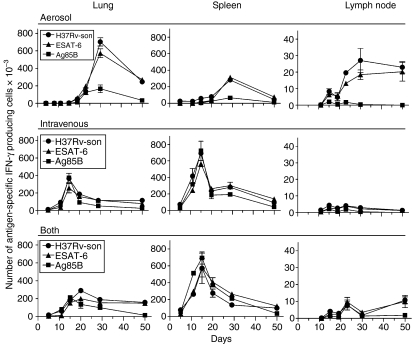Figure 5.
Changes in the total number of CD4 cells capable of making interferon-γ (IFN-γ) in response to ESAT-6 (1-20) peptide, Ag85B (240-54) peptide, or a Mycobacterium tuberculosis (Mtb) sonicate, according to the IFN-γ enzyme-linked immunosorbent spot-forming cell assay. In the lungs of mice infected via the respiratory route alone Mtb-specific CD4 began to increase after about day 20 of infection to peak on day 30 before undergoing a decline. By contrast, in the lungs of mice infected via the i.v. route or via both routes Mtb-specific cells began to increase in number much earlier to peak on day 15 and day 20, respectively. In the spleens of mice infected via the i.v. route or via both routes the production of antigen-specific IFN-γ-producing cells began after about day 5 to peak on day 15, whereas in mice infected via the airborne route alone production did not begin until after day 20 and did not to peak until day 30. In the draining lymph nodes (LNs) of mice infected via the airborne route day 30 was again the time of peak production of IFN-γ-producing cells. The number in the LNs of mice infected via the i.v. route or both routes was too small to make comparisons. Means ± SD of results obtained with cells of four mice per group per time-point.

